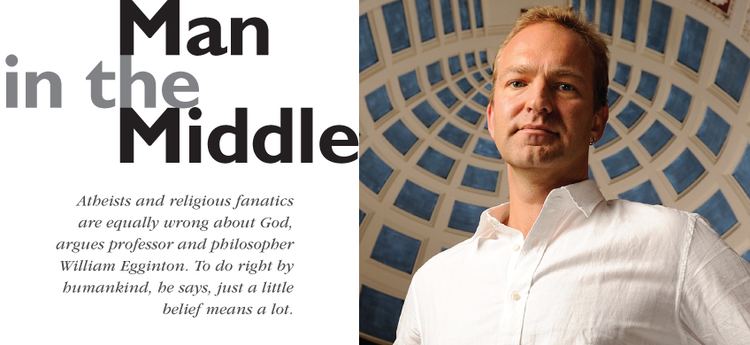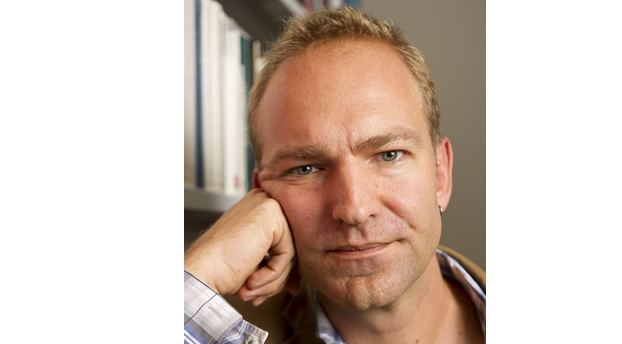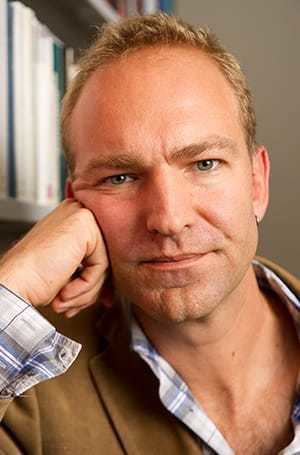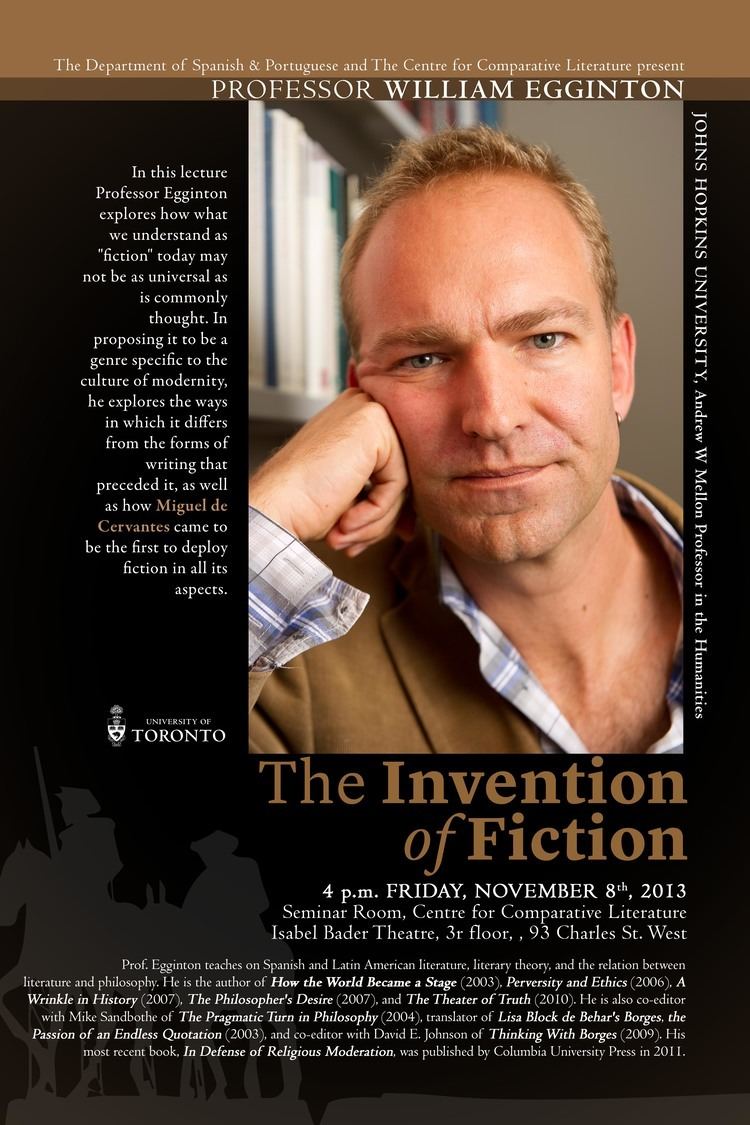Nationality American | ||
 | ||
Occupation Literary Critic, Literary Theorist, Philosopher, Professor at The Johns Hopkins University Subject Spanish and Latin American Literature, Cervantes, Borges, Fictionality, Psychoanalysis, Continental Philosophy Books The Man Who Invented, In Defense of Religious, How the World Became, The Theater of Truth: Th, Perversity and ethics Similar Mike Sandbothe, Michael Marder, Miguel de Cervantes, Jorge Luis Borges | ||
William Egginton (born 1969) is a literary critic and philosopher. He has written extensively on a broad range of subjects, including theatricality, fictionality, literary criticism, psychoanalysis and ethics, religious moderation, and theories of mediation.
Contents
- Life and career
- Works and thought
- How the World Became a Stage Presence Theatricality and the Question of Modernity
- The Theater of Truth The Ideology of NeoBaroque Aesthetics
- The Man Who Invented Fiction How Cervantes Ushered in the Modern World
- Theoretical Foundations and Conceptual Reconciliation
- References

Life and career

William Egginton was born in Syracuse, New York in 1969. He received his PhD in Comparative Literature from Stanford University in 1999. His doctoral thesis, "Theatricality and Presence: a Phenomenology of Space and Spectacle in Early Modern France and Spain," was written under the direction of Hans Ulrich Gumbrecht. He currently resides with his wife, Bernadette Wegenstein, three children, two cats and a dog in Baltimore, Maryland. William Egginton is the Andrew W. Mellon Professor in the Humanities at the Johns Hopkins University, where he teaches on Spanish and Latin American literature, literary theory, and the relation between literature and philosophy.
Works and thought

William Egginton is the author of How the World Became a Stage (2003), Perversity and Ethics (2006), A Wrinkle in History (2007), The Philosopher's Desire (2007), The Theater of Truth (2010), and In Defense of Religious Moderation (2011). He is also co-editor with Mike Sandbothe of The Pragmatic Turn in Philosophy (2004), translator of Lisa Block de Behar's Borges, the Passion of an Endless Quotation (2003, 2nd edition 2014), and co-editor with David E. Johnson of Thinking With Borges (2009). His most recent book is The Man Who Invented Fiction: How Cervantes Ushered In the Modern World (2016). In 2017, Bloomsbury will publish Medialogies: Inflationary Media and the Crisis of Reality, a collaboration between William Egginton and David R. Castillo.
How the World Became a Stage: Presence, Theatricality and the Question of Modernity

How the World Became a Stage inverts traditional assumptions about the relationship between a person’s worldview and the media that they consume. Moving beyond the common observation that a person’s way of seeing the world impacts the way that they experience cultural expressions like literature, Egginton argues that new forms of media also give rise to new ways of negotiating and understanding the world in which they appear. How the World Became a Stage argues that such mediated experiences, and specifically those associated with theatrical convention, historically laid the groundwork for many ways of thinking and understanding the world that are now taken for granted as essential part of the Western intellectual tradition. On his argument, the fundamental shift from a Medieval European mentality, one characterized by a way of viewing the world that allotted all things –including humanity- their place within a vision of a harmonious divine creation, to a Modern picture of the world was made possible by the emergence and elaboration of theatrical modes of representation. While what Egginton dubs the "fullness" of the medieval world hinged on the possibility of everything being present and fully itself, the worldview of Western Modernity is essentially theatrical in nature. It presents an "empty" form of the world, one in which the promise of truth is always in danger of being feigned or otherwise slipping away.
Egginton explores how the injection of the logic of masking, persona and mise en abîme into the theater allowed for the construction of character, audience, and reality as one frame of reality among others. Each of these innovations required an education in a new set of skills in order to be understood: actors must learn to perform as if they were their characters, spectators must learn to differentiate between an actor and the character that they play, and both actor and spectator must learn to differentiate between the "real world" space occupied by the spectator and the performative space of the theatrical representation. Spurred on by its massive popularity in the 16th Century, theatrical audiences quickly learned to negotiate the different layers of meaning presented on stage in order to comprehend increasingly sophisticated narrative devices like the meta-theatrical structure of a play-within-a-play. In doing so, the public also learned to understand themselves differently by recognizing that, instead of possessing a stable and unchanging identity, they were also actors performing their roles for other people who likewise play their parts for the world around them. From the 16th Century on, this theatrical understanding of the world would become increasingly dominant while the medieval "magical worldview" would diminish in application and importance (albeit without ceasing to exist as a possibility). This newfound dominance changed the way that people imagined themselves and the world around them. It coded their experiences and understanding in a decidedly theatrical language, and ultimately gave rise to the existential phenomenon of "subjectivity" and "subjective experience." On Egginton’s argument there is little difference between "subjectivity" and the world experienced through the lens of "theatricality." Indeed, he argues that an adequate historicization of the emergence of the theater and its associated phenomena allows for the vocabulary of subjectivity to be subsumed into the vocabulary of theatricality.
The Theater of Truth: The Ideology of (Neo)Baroque Aesthetics

While How the World Became a Stage begins by arguing that subjectivity and the Modern worldview are historically grounded in the conventions and logics of theatricality, The Theater of Truth continues that thought by exploring how attempts to address problems that stem from the "theatricalization of space" give rise to the Baroque. Egginton sets out to demonstrate that the Baroque is fundamentally theatrical: "The Baroque is theater, and the theater is baroque." Although the work engages with a diversity of cultural productions hailing from the historical Baroque period, Egginton’s primary concern is to redefine the Baroque, not as an aesthetic category, but instead as first and foremost a "problem of thought" that embraces and impacts the totality of the societies wherein it emerges: "A problem of thought is a problem that affects or unsettles an entire culture in the largest possible sense, that permeates its very foundations and finds expression in its plastic art, in its stories and performances, in its philosophy as well as in its social organization and politics". Egginton argues that the Baroque names the fundamental problem of thought of Modernity, and defines that problem accordingly:
Let us stipulate, then, a definition: Modernity’s fundamental problem of thought is that the subject of knowledge can only approach the world through a veil of appearances; truth is defined as the adequation of our knowledge to the world thus veiled; hence, inquiry of any kind must be guided by the reduction of whatever difference exists between the appearances and the world as it is. […] the Baroque puts the incorruptible truth of the world that underlies all ephemeral and deceptive appearances on center stage, making it the ultimate goal of all inquiry; in the same vein, however, the Baroque makes a theater out of truth, by incessantly demonstrating that truth can only ever be an effect of the appearances from which we seek to free it.
Egginton holds that the Baroque involves the problematization of the difference between appearances and a truth external to those appearances. He dubs this specifically Modern problem "sense-disassociationism." Egginton stakes out the presence of two strategies that emerge as ways of dealing with the disassociation of truth and appearance, namely, the "major and minor strategies" of the Baroque. As per his theory, the Baroque’s "major strategy" "assumes the existence of a veil of appearances, and then suggests the possibility of a space opening just beyond those appearances where truth resides." To the contrary, the "minor strategy of the Baroque" resists the possibility of a final revelation of truth, but it does by unexpectedly embracing the major strategy’s assumptions and carrying them to their own paradoxical ends:
The second, minor strategy does not take the obvious path of denying the reality behind the veil. […] It nestles into the representation and refuses to refer it to some other reality, but instead affirms it, albeit ironically, as its only reality. This strategy, then, rather than accepting the presupposition of two opposing levels – a representation and a reality independent of that representation –undermines our ability to make this distinction in the first place. Not, however, in order to lead us further astray from "reality itself," but rather to make us aware, to remind us that we are always, at any level, involved with mediation.
The Theater of Truth concludes by arguing that, rather than historical or aesthetic markers, the Baroque and Neobaroque are more rightly understood as the respective opening and closing of "the new space of modernity’s relation to the possibilities of its own knowledge."
The Man Who Invented Fiction: How Cervantes Ushered in the Modern World
Although literature occupies a place of prominence in almost all of Egginton’s works, The Man Who Invented Fiction primarily focuses on the works of Miguel de Cervantes Saavedra in order to argue that that author’s works, and Don Quixote in particular, invented fiction. The Man Who Invented Fiction describes how that invention was made possible by both Cervantes’s theatrically-informed innovations of the notion of character and the author’s own struggle with disillusionment:
What makes Cervantes’s writing unique is how he drew on his disillusionment to shape not only what he was writing about, but also how he wrote. […] One way Cervantes achieved his innovation was thus by importing into his writing an idea he learned from the theater: that we can play roles without believing in them; and that this difference between what a person seems to be on the outside and what he or she feels or thinks on the inside is essential when creating a character and making it come to life.
Egginton argues that fiction is in its essence much more than a literary genre: it is also a way of understanding the world that this new form of writing makes possible. In this larger sense, Egginton understands fiction as the ability to negotiate different frames of reality while suspending judgment regarding the truth of what is presented. On Egginton’s account, that suspension of judgement allows for the reader to enter the reality of a work and encounter other subjective modes of truth within a factually untrue narrative:
Fiction presents the untrue in the form of truth, poetry in the form of history, and in doing so, allows access to a different kind of truth –not Aristotle’s more general truth, divorced from the specificity of character, but rather its very opposite: subjective truth, a truth so internal, so specific to how individuals inhabit their world, that it would pass forever unnoticed by a history confined to grasping human actions from the outside.
The exploration of character made possible through Cervantes’s invention of fiction also gives rise to another essential literary possibility: just as people come to understand that others, like they themselves, are constituted by the performance of the part that they play, they may also, through fiction, enter into the place of others. Egginton argues that this theatrical understanding of self, coupled with Cervantes’s innovatory notion of character, first made it possible to imaginatively explore the lives, affections, sentiments, and struggles of other members of society in a meaningful, “three-dimensional” way. In doing so, Egginton also signals a further possibility opened up by Cervantes’s literature, namely, the possibility of developing a sense of literary empathy by considering the joys and sorrows of other people.
Theoretical Foundations and Conceptual Reconciliation
The theoretical underpinnings of Egginton’s primary line of argumentation throughout How the World Became a Stage, The Theater of Truth, and The Man Who Invented Fiction have been elaborated in detail in several theoretical works, including Perversity and Ethics and The Philosopher’s Desire: Psychoanalysis, Interpretation and Truth. Perversity and Ethics is Egginton’s first book-length foray into psychoanalytic theory, and focuses on the paradoxical status of evil, perversion, and crime in their putative opposition to the good, “right discourse” (orthos logos), and Law. Egginton elaborates the concept of the “fault-line,” a structure that can only be “institutionalized” on the condition that it includes, and indeed brings about, the transgressions that it purports to prevent. Perversity and Ethics argues that our ethical lives function by imposing just such a structure upon ourselves:
What the story of Eve’s reveals, however, is that the poles of ethical and perverse action, their roles as absolute motivators of behavior, are from the outset hopelessly intertwined. To do the right thing, or the wrong thing, means to be primordially inhabited by what I call the ethical fault-line, a rift at the core of identity that drafts the blueprint for the moral self and orients the self’s desire.
The Philosopher’s Desire attempts to reconcile the deconstructive thinking of Jacques Derrida, Gilles Deleuze’s ontology of repetition, the phenomenological hermeneutics of Martin Heidegger, and the insights generated by Freudian and Lacanian psychoanalytic theory regarding interpretation and the structure of truth. True to its name, the work describes the motivations and reasoning that give rise to the “philosopher’s desire,” which Egginton describes as humanity’s drive to seek a truth beyond appearances, a master key capable of decoding the total significance of reality. Egginton argues that, despite its necessary failure, such a desire nevertheless plays an indispensable role in the evolution of Western thinking about the self, interpretation, and truth.
